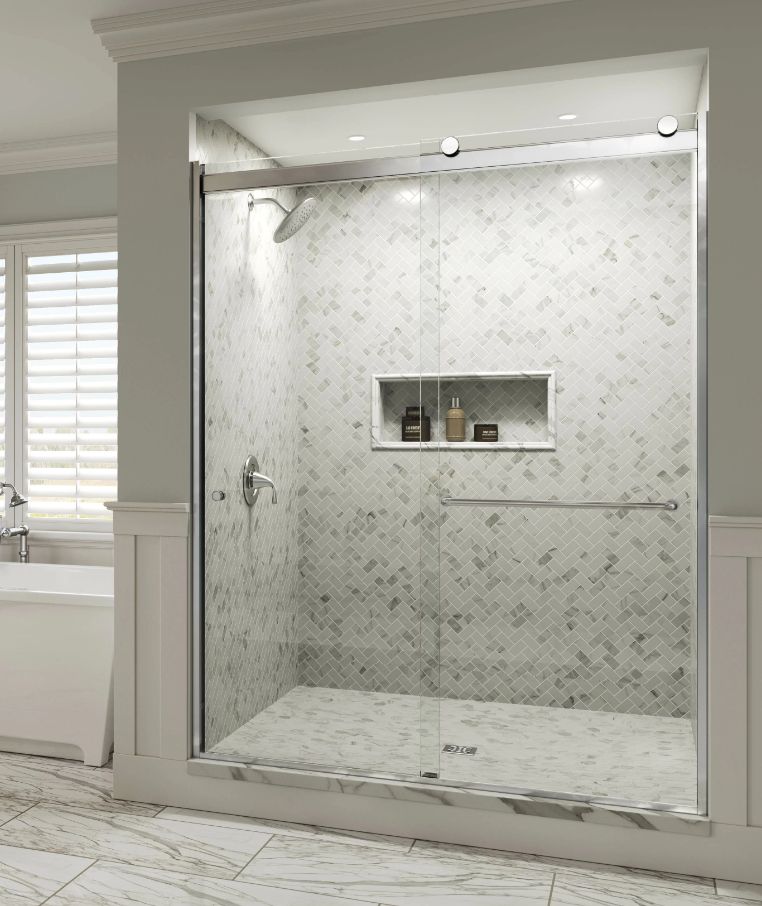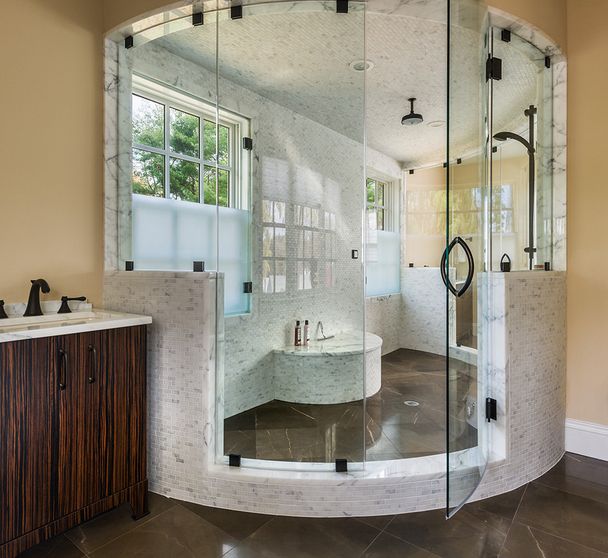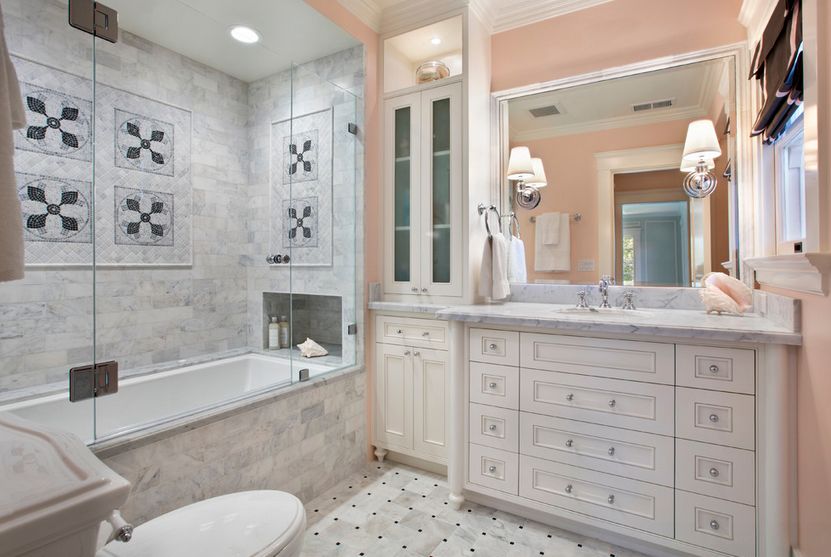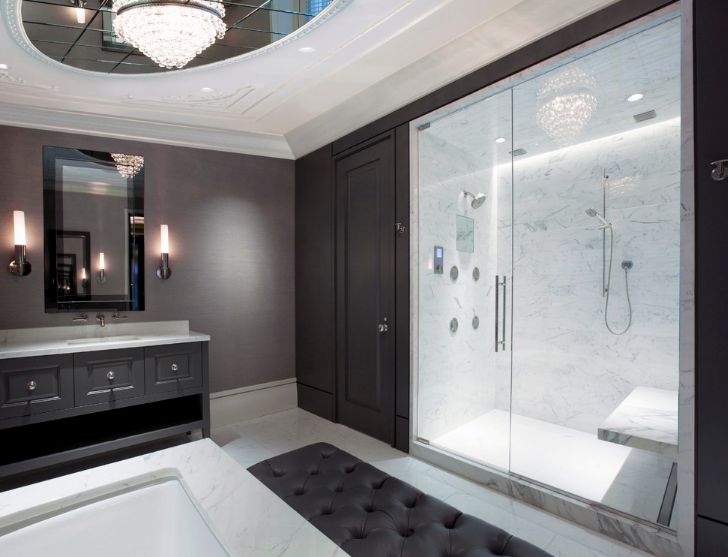Choosing the best types of shower doors is an important part of designing a bathroom. After all, the shower takes up more space than any single item, and the shower doors you choose can help you streamline your design for efficient use of space. Also, shower doors are a distinctive part of the style of any bathroom design.

Most of these shower doors have a more contemporary and streamlined style that does away with the need for a shower curtain. Still, the most vital factors in deciding which shower door is best is understanding your style, budget, and space needs.
Types of Shower Doors
Here are some examples of common shower door designs for you to consider if you are planning a new bathroom design or even a remodel of an old shower.
Shower Doors: Types of Closure Designs
You can choose a shower door based on the way that it closes. This is the most important factor if you are choosing a shower door option based on limited space as some doors will take up more room than others to maneuver.
Bi-Fold Shower Doors

This kind of door features a hinge connecting the two panels that allows the door to fold inward when you push it open. This is a space saving feature as it uses just the area inside the shower to open.
Pros
- This is a space saving shower door option.
- A bi-fold door is one of the most common types of shower doors that you can find in many sizes.
Cons
- The frame can inhibit the view out of the shower doors as there is a higher ratio of frame to glass panels than other options.
- This kind of door will look cheap if the glass panels are thin and the metal frame is of poor quality.
Sliding Shower Doors

Sliding shower doors, also known as bypass doors, are another space saving option as the door slides to follow the glass panel that is beside it. Of course, this means that the door takes up no more space meaning that you can use it in smaller bathrooms. There are options for a framed and frameless sliding shower door. However, the framed shower doors are the most common type.
Pros
- You can use bypass doors in small bathrooms as they take up very little space.
- Sliding doors are one of the most cost-effective shower doors that you can choose.
Cons
- Many sliding glass shower doors need a metal frame on the top and bottom which can attract dust and debris.
- For most sliding shower doors, the opening is smaller than for other shower door options.
Pivot Doors
Pivot doors open like a standard door with a hinge mechanism on one side with a handle on the other. A pivot door can be used on many shower stall types including a straight or curved shaped shower enclosure.
Pivot hinges differ from regular hinges in that they allow you to open the door both inward and outward. One option to save space with pivot doors is to mount the pivot hinges in the middle to create a revolving door that opens from either side.
Pros
- Pivot shower doors are easier to clean than those with frames as there is nowhere for dust and debris to hide.
- You can customize pivot shower doors for many different shapes.
- Pivot shower doors allow for a larger opening than sliding glass shower doors.
Cons
- Water droplets pool on the ground as you open and close this kind of shower door. Also, water may escape the bottom of the shower as there is no frame at the bottom to hold in the water.
- Hinged glass shower doors take up more room than other shower door types as they need room if you want to open the door outward.
Shower Enclosure
Rather than use shower doors at all, you might opt for a shower enclosure with no movable door. This option wraps around to create a smaller opening than just stationary panels might. This kind of shower is perfect for stand alone showers and has a more modern aesthetic than framed shower doors. Most people create shower enclosures with glass blocks, tile, or stone.
Pros
- This kind of shower option has no door to break or clean.
- Showers with these kinds of designs have a distinctive and luxurious look.
Cons
- There is less privacy with this option as there is no shower door to block the view inside.
- Depending on the size of the shower surround, you may have water leakage as there is no door to hold in water.
- Cold air comes in through the opening, and the shower does not hold in the steam for extra warmth.
Tri-Fold Shower Doors

Tri-fold shower glass doors are similar to bi-fold doors except rather than two glass panels there are three glass panels. These can be full sized from the floor to the top of the shower. Also, tri-fold doors are used as a bathtub door that you fit on the top of the side of the bathtub to create a shower enclosure.
Pros
- This is a versatile option as you can use it for multiple shower styles.
- Folding doors are a space saving option as the glass panels fold in upon themselves. Therefore, they don’t take up valuable space in small bathrooms.
Cons
- This kind of door is not as long lasting as a stationary or a sliding door.
Stationary Glass Panel

If you are looking for a sleek but cost effective option, try a stationary panel. For example, the panel for this bathtub, is placed on top of the sides of the tub on the side of this shower. This eliminates the need for shower curtains, but it still blocks most of the water from the spraying shower head.
Pros
- As there are less moving parts, this kind of shower door is a less expensive option than moving shower doors.
- This kind of shower door has a streamlined look and function which creates a more modern aesthetic.
Cons
- There is less privacy with a stationary door on a walk-in shower as it does not close and can block just a portion of the shower.
- Stationary panels allow more water to escape. Therefore, it is important to choose the correct shower head to minimize spraying in the direction you don’t want.
Shower Doors: Types of Shower Shape
You also choose a shower door based on the shape of your shower. Certain shapes take up more room than others, and it is important to understand which shapes are more space efficient.
Round Doors
Round shower doors have a modern style that looks wonderful in contemporary or modern settings. These can be hinged doors or a sliding glass door style. This kind of design gives the most shower area in a corner space.
Pros
- This kind of shower door gives your bathroom a distinctive style.
- This kind of door helps you make the most of shower space as the rounded shape gives more room to the person inside the shower.
Cons
- This kind of shower door is unique and less available than other options. Therefore, this door is also more expensive.
- Curved shower doors take up valuable bathroom space.
Neo Angle Shower Doors

Neo angles shower doors work well as corner shower doors as they are space saving options for corner spaces. This design features an angled door with two stationary glass panels and two shower walls form a total of five sides. This type of door features a full view inside the shower, so this door works well to display custom tile work.
Pros
- There is less tile or shower wall needed for this option.
- This type of shower door creates an open look that is attractive in a corner shower.
Cons
- These kinds of shower doors are more complicated to install, so you may need the help of a professional.
- This look is not as classic as other styles and may look dated at some point in the future.
Shower Doors: Types of Structural Support
The more structural support you need for your shower, the more metal frame you will need. Still, if you have a more modern look in mind, the less framing the better.
Framed Shower Doors

Framed shower doors use metal frames to support the glass walls and doors for the shower. These are a more common option for shower glass doors so these are easier to find and are less expensive than frameless glass style. Also, framing may seem like a dated option, you can find more modern framed doors like the one in burnished gold in the example above.
Pros
- Framed doors are less expensive and more plentiful than frameless shower doors.
- Framed enclosures have metal framing with rubber seals that keep water inside. Therefore, there are fewer leakages than with frameless options.
Cons
- Many framed shower doors use inferior metals for the framing that will look dated and need more repairs than frameless shower doors.
- The metal frame can trap dust and debris making it harder for you to clean than a frameless door option.
Frameless Shower Doors
Frameless shower doors have a modern and seamless aesthetic style. In addition, it is a more minimal look because there is no framing to complicate the look. However, a frameless shower door will still require metal brackets to hold the doors and glass in place. Most frameless shower doors utilize heavy glass unlike their framed counterparts.
Pros
- This is an up and coming look for shower glass doors that works well with a variety of styles.
- Frameless doors give your bathroom an open look that doesn’t detract from the shower behind the doors.
Cons
- This style door uses heavy glass and is expensive to install.
- Because there is no frame, these doors and panels can leak water.
Semi-Frameless Shower Doors

A semi frameless shower door offers the best of both worlds between the completely frameless and framed shower door options. Many times, these shower glass doors will have framing on the top and bottom without framing on the sides.
Pros
- The semi frameless shower doors mitigate some of the difficulties in frameless doors in that they prevent water leakages.
- Even though it has a partial frame, the semi frameless shower glass door creates an open style bathroom.
Cons
- This shower door option is more expensive than framed door enclosures.
- This is not as minimal a style as frameless doors.
Shower Doors: Types of Decorative Glass
In addition to varying the closure and support option, you can choose different types of glass to make your bathroom more unique or to increase the privacy in the shower.
Frosted Glass Door
Frosted shower doors are one of the most common types of decorative glass shower doors. This style looks as if there is a permanent steam build up in the shower area. This kind of glass style brings greater privacy to a bathroom. This works well if there is just one bathroom for multiple people.
Pros
- These glass doors and panels increase the privacy in the shower area.
- Frosted glass doors are easy to maintain and keep clean as they hide water spots.
Cons
- Frosted glass doors cut off the line of site into the shower making the bathroom feel more closed.
- This kind of glass can make your bathroom appear darker because light doesn’t reflect well into it.
Pebble Glass Panels
Pebble glass has a look that is similar to hammered metal. This style is not as opaque as frosted glass but it provides some distortion to the people and objects on either side of the glass.
Pros
- This decorative texture and others like it gives more privacy to your shower space without cutting off the line of sight.
- This is a unique style for glass doors and panels.
Cons
- This glass may not have a timeless look.
Tinted Glass
If you want a bathroom that is a unique style, you can try tinted glass. Tinted glass is similar to frosted glass but instead of white, the fabricators create various colors. This type of glass works well in contemporary design styles.
Pros
- Tinted glass gives your bathroom a unique and distinctive contemporary style.
- Tinted glass is opaque which gives you more privacy in the shower.
Cons
- This style may not work for everyone and make your home not as attractive to potential buyers.
- Tinted glass cuts of bright sunlight to your shower making it more dark.
Clear Glass Panels
If you want a classic or traditional look for your shower, it makes sense to use clear glass shower doors. These do not give the shower as much privacy as other glass options, but it is the most minimal option if you are trying to highlight other aspects of the bathroom like the tile.
Pros
- Clear glass doors and panels have a timeless look that other decorative options don’t have.
- Clear glass has a minimal look and gives the bathroom an open and airy appearance.
Cons
- There is no privacy with a clear shower door like some of the other decorative options provide.
Shower Doors: Type of Shower Purpose
Most shower doors are used for showers and create privacy and block water from getting onto your floor. However, some doors for shower areas have a different purpose.
Steam Door
If you want your shower to have a dual purpose like a general shower door and to create a steam room, you will need another type of door known as a steam door. A steam door goes from the ceiling to the floor and creates a seal that builds up steam inside the shower. Likewise, you can have a smaller steam shower door if there are other glass panels that meet the door to close in the steam.
Pros
- A steam door works well for people who want the health benefits of a steam room in their own home.
- This kind of shower can increase the attractiveness of your property.
Cons
- Steam doors are difficult to install. Thus, you need a professional to help you with the complex fitting and measuring.
- A steam room and door can breed mold and be prone to rust due to the constant exposure to moisture.
Frequently Asked Questions (FAQ)FAQ
Which type of shower door is easiest to clean?
Stationary panels made from frosted or other decorative glass are easiest to clean. The stationary panels mean that there are no metal frames to get in the way of cleaning and to trap dirt and mold. Also, decorative glass shows less water spots than clear glass making it easier to clean and maintain. The next category that is easier to clean would be frameless doors as there are fewer items affixed to the glass.
What type of glass is best for showers?
The best type of glass depends on what you want. If you need privacy, a decorative glass option like frosted or tinted works well. However, if you want a modern and streamlined look, clear glass is the best option.
What is the difference between a pivot and hinged shower door?
Pivot shower doors have a special kind of hinge that allows it to swing in either direction. In contrast, classic hinged doors open in just one direction.
What is the most common shower door size?
The most common size standard size shower door is 72 inches high with a width from 22 to 36 inches.
Conclusion
There are many types of shower doors, each with their benefits and drawbacks, and it can be confusing to try to find the best kind. First, it is important to understand your needs. Next, consider your space. Then, look at your budget. Using these factors, you can choose the type of shower door that works best for you and for your space.
The post 16 Types of Shower Doors and How to Choose the Right One appeared first on Homedit.








0 Commentaires